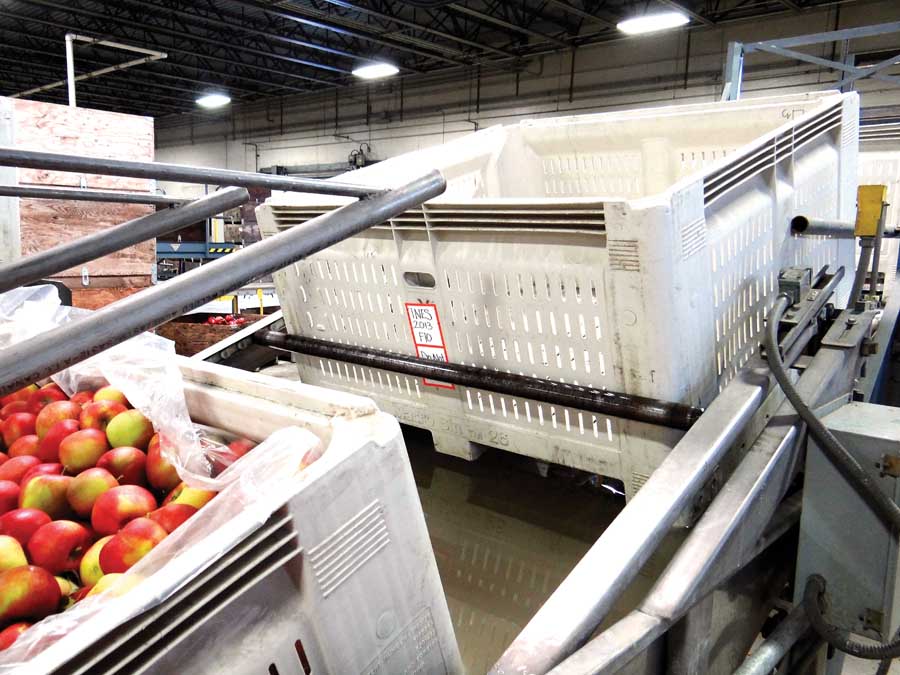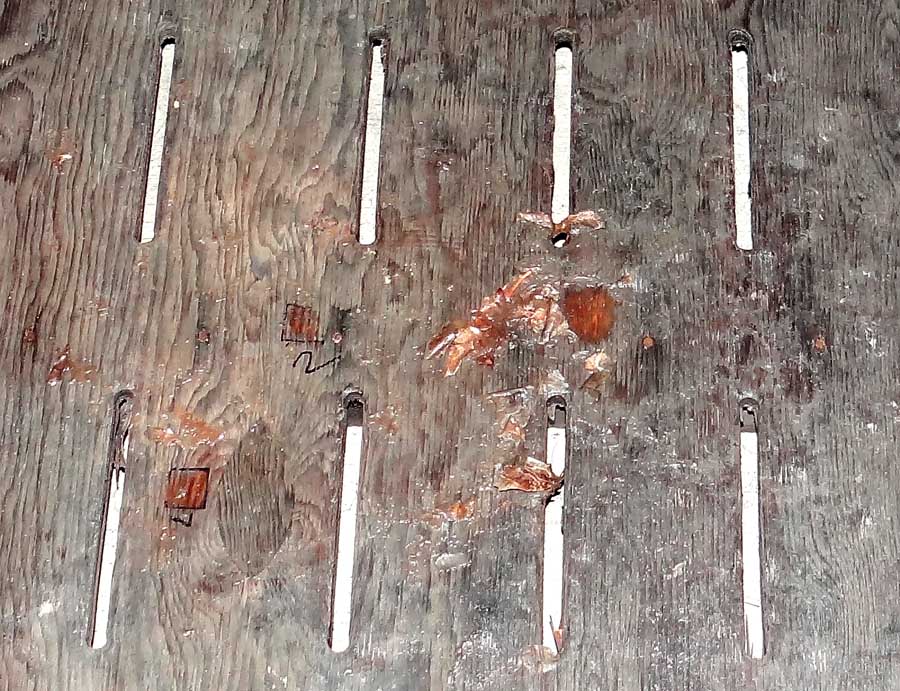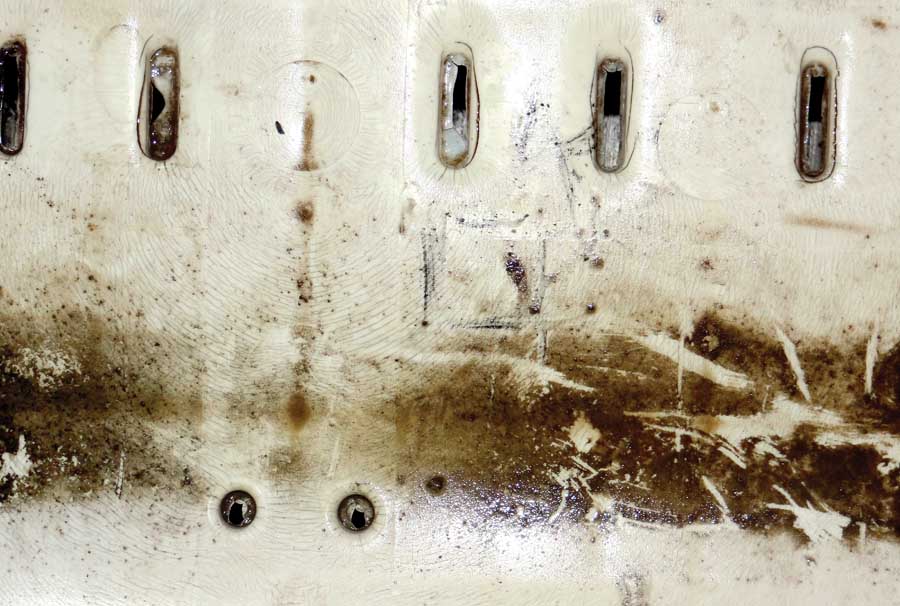
Plastic bins go through a dump tank in an apple packing house. (Courtesy Ines Hanrahan)
Tree fruit packers must take additional steps to ensure that bins are examined and receive adequate treatment throughout bin handling, new research shows, in one of the first studies to examine cleaning practices for wooden and plastic bins.
The two-year study, funded by the Center for Produce Safety, identified several important factors to assist the industry in the face of increasing scrutiny of its food safety practices.
Researchers worked with individual packing houses on the study.
Their goals: to evaluate current practices for reducing overall microbial levels on both wooden and plastic apple bins and to identify new strategies to maintain bins in sanitary condition throughout the season.
The researchers worked with each packing house to develop data collection methods that minimized interference with production for each operation, while allowing the scientists to examine key practices during normal packing line operation.
In one facility, fruit bins were tracked over time, and in some cases, research included several trips from the packing house to the orchard and back.
Four collaborating packing houses worked with scientists to evaluate cleaning practices during packing. Other packing houses “loaned” bins to the researchers to capture data about specific types of wooden and plastic bins.
“The level of collaboration between the university, the Washington Tree Fruit Research Commission and the industry representatives to achieve these results was truly remarkable and greatly appreciated,” said Karen Killinger, formerly of Washington State University, who led the study.
Overall, researchers found both wooden and plastic bins could become heavily soiled and present difficulties for “cleanability.”
Since wood and plastic both posed challenges, neither was better than the other. Standard industry practices need to be adapted to increase the percentage of bins that are clean after treatment and before being sent back to the orchard to be filled, the study showed.
As long as the bins were in good repair, bin age did not appear to influence the ability to clean the bins.
“That’s good news, because we have some wood bins up to 40 years old in the industry, and there has also been a general concern about wooden bin usage,” said Ines Hanrahan, projects manager for the Washington Tree Fruit Research Commission, who collaborated on the study with Killinger.
However, Hanrahan said, packers should definitely add steps to their cleaning and sanitizing processes to ensure microbial loads and food safety risks are adequately reduced, if visible debris (rotten fruit pieces, soil, leaves, etc.) is present in bins before deployment into the orchard.
Defining cleaning and sanitizing
The first key to the process is understanding the difference between cleaning and sanitizing.
Cleaning is the process of removing soil, minerals and other agents from a surface typically with the aid of a cleaning agent, while sanitizing is the process of reducing the number of microorganisms on a properly cleaned surface to a safe level.
Sanitizing is often accomplished by using either heat or chemicals. A surface must be effectively cleaned first for a sanitizing treatment to work as it should.
In addition, some chemical sanitizers, including chlorine, are highly reactive and must be carefully managed.
Chlorine can react with organic matter and become less effective over time as debris accumulates in the sanitizing solution or may dissipate over time at certain temperatures or pH ranges.
Study results

Debris was found on wooden and plastic bins following dump tank treatments. (Courtesy Ines Hanrahan)
A survey from the study found most packers use dump tanks treated with chlorine to clean bins before returning them to the orchard to refill with fruit for packing.
Some also employ pressure washing or peracetic acid (PAA) in their dump tanks.
Those practices do not adequately clean bins before sanitizing them, Hanrahan told Good Fruit Grower. Sanitizing treatments can be overwhelmed by the organic load in a particularly dirty bin, she said, and neither chlorine nor PAA in dump tanks consistently reduced microbial loads on bins significantly.
For wooden and plastic bins, total coliforms and generic E. coli were quantified before and after treatment. The study also examined the levels of chemical treatment.
For chlorine, oxidation-reduction potential (ORP), measured in millivolts, examined the chemical activity of the chlorine.
The study showed that the number of positive samples did not decrease in the majority of wooden and plastic bins when subjected to standard chlorinated dump tanks with levels of chlorine at 774 mV (a mV is 1/1000 of a volt, a measure of electrical potential).
Increasing the levels to 849 mV did not dramatically improve sanitizing in wooden bins (only one-third of wooden bins decreased in positive sampling sites).
In addition, using PAA in the dump tank for wooden bins was not an effective strategy to reduce microbial levels on sampled surfaces.
Plastic bins were not tested at higher chlorine levels or for PAA due to lack of availability at certain packing houses.

Debris was found on wooden and plastic bins following dump tank treatments. (Courtesy Ines Hanrahan)
Hanrahan noted that there are challenges with dump tank management and water recycling that need to be reviewed at many packing houses.
Any high-risk practices (such as infrequent water change schedules or water recirculation) as well as cleaning protocols should be assessed, she said.
The study showed that packers’ challenges with management of dump tank water and of chlorine levels make dump tanks inappropriate as cleaning or sanitizing strategies for bins.
However, promising new techniques were identified. A novel heat treatment involving immersing bins in hot water was tested.
Additionally, adding treatments after a pressure wash, using an application of a cleaning solution, water rinse followed by a sanitizer treatment, was also examined.
Following pressure washing alone, 43 percent of plastic bins decreased in the number of positive samples, though that increased to 52 percent when cleaning and sanitizing treatments were added to the process.
For 71 percent of wooden bins, the number of positive samples actually increased when pressure washing was employed, indicating the bins had more microbes present or “active” after pressure washing.
However, 65 percent of wooden bins had the number of positive sampling sites decrease when pressure washing was followed by application of cleaning agent and then a sanitizer.
After a hot water treatment, the majority of plastic bins — 60 percent — decreased in the number of positive samples.
Most wooden bins did not decrease in positive samples after hot water treatment alone, but when bins were put through a chlorinated dump tank treatment, followed by hot water treatment, 78 percent of wooden bins decreased in positive samples.
Hanrahan said packers should consider additional steps to ensure bins are adequately cleaned — a chlorinated dump tank followed by hot water treatment or a pressure wash followed by cleaning and sanitizing washes, separate from the dump tank, if visible debris remains in bins.
CPS (www.centerforproducedsafety.org) funded the research, with an in-kind contribution of WTFRC staff. •
– by Shannon Dininny






I didn’t know that there was a difference between cleaning and sanitizing. Until I found this site I assumed they were interchangeable terms, but knowing that there are two processes that are used is good to know. I’ll keep this in mind if I need a sanitary service.